We may not have the course you’re looking for. If you enquire or give us a call on +352 8002-6867 and speak to our training experts, we may still be able to help with your training requirements.
Training Outcomes Within Your Budget!
We ensure quality, budget-alignment, and timely delivery by our expert instructors.
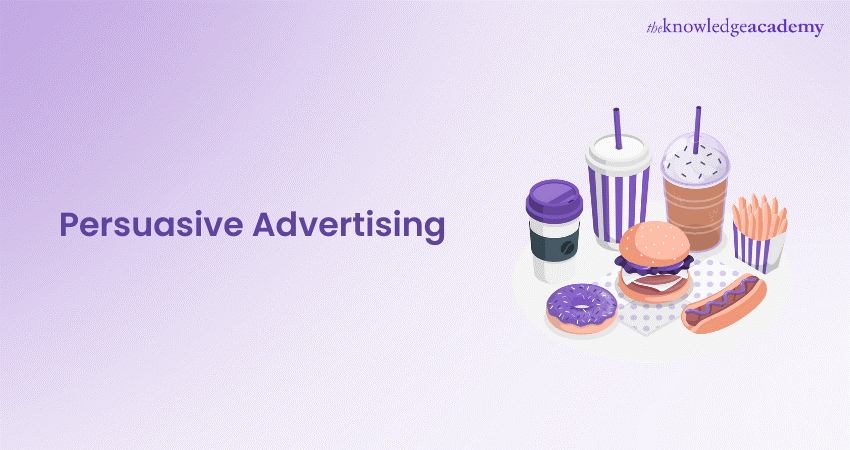
Captivate, connect and compel – These are the three pillars that hold the art of Persuasive Advertising together. This form of Advertising drives brands from their ordinary origins to extraordinary heights of marketing excellence by harnessing the power of persuasion. It ignites customers’ curiosity by tapping into their needs and desires through emotional storytelling, eye-catching visuals, and creating a sense of urgency that turbocharges customer action.
This blog brings together the best techniques and examples from renowned brands that exemplify the power of Persuasive Advertising. So read on, get inspired, mastermind creative ad campaigns and transform your brand from good to irresistible!
Table of Contents
1) Understanding Persuasive Advertising
2) The Three Key Categories of Persuasive Advertising Techniques
3) Common Persuasive Advertising Techniques
4) Six Examples of Persuasive Advertising
5) How to Make a Strategy for Persuasive Advertising?
6) Conclusion
Understanding Persuasive Advertising
Persuasive Advertising is an Advertising technique that attempts to convince a consumer to purchase a product or service by appealing to their desires and needs. This method aims to frame products in a positive light and convince consumers about its attractive benefits. This form of Advertising prioritises emotional responses instead of facts to motivate consumers.
Key Points:
a) Appeals to Desires and Needs: Targets the emotional and psychological aspects of consumers.
b) Positive Framing: Presents products in a favourable light to enhance their appeal.
c) Emphasises Benefits: Highlights the attractive features and advantages of the product or service.
d) Emotion Over Facts: Uses emotional triggers rather than factual information to influence purchasing decisions.
The Three Key Categories of Persuasive Advertising Techniques
As mentioned above, the goal of Persuasive Advertising is to appeal to the target audience’s emotions and gain their trust. To accomplish this, you can choose between three main categories of Advertisements that utilise persuasive techniques: ethos, logos, and pathos. Let's explore them in detail:
Pathos (Emotional Appeal)
The pathos category aims to connect emotionally with the audience, appealing to both positive and negative emotions. Ways to convince the audience include using
a) Memory
b) Shared experience
c) Nostalgia
d) The senses
These make audiences feel an emotion while helping them understand what you offer. It's about making a compassionate pitch that stirs them into action. Examples of pathos ads include images of a loving mother and child, an adorable puppy, a distraught family, or a painful condition.
Ethos (Credibility)
The ethos category of Persuasive Advertising centres on messaging that establishes trustworthiness and credibility. This can be accomplished through a respected celebrity, expert, or well-known brand who endorses a product or service. This speaker can convince the audience that they are trustworthy, reliable, ethical, and of good character and that their words can be trusted.
Logos (Logic and Reason)
The Logos persuasive ads category utilises reason, logic, and rationality to persuade an audience. These ads may use statistics, data, facts, graphs, or tables to engage the logical mind of their audience. The primary objective of these ads is not to evoke emotions but to engage the intellect by highlighting what makes the product or service unique.
Persuading consumers is the key to boosting business success. Learn the art of persuasion in our comprehensive Persuasion Training - Sign up now!
Common Persuasive Advertising Techniques
Now that we have established how Persuasive Advertising techniques can be essential tools for influencing Consumer Behaviour, let's explore some of these proven strategies. From bandwagon effect and humour in Advertising to celebrity endorsements, the list below highlights the best tools available for marketeers to excel in Persuasive Advertising
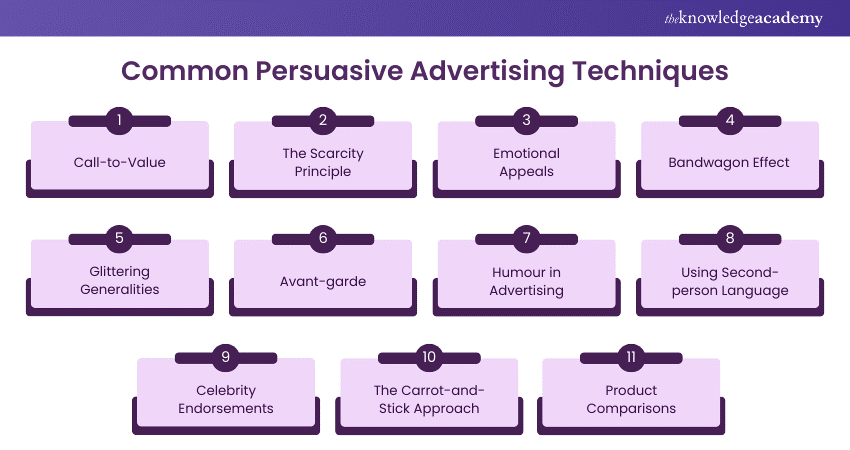
Call-to-Value
This technique uses a call-to-value in the ad copy instead of a call-to-action. The Advertisement clearly communicates the product's value to consumers, allowing them to visualise the potential benefits of purchasing it.
The Scarcity Principle
If a product is scarce in quantity, it can become valuable in the eyes of others. This is the logic behind the scarcity principle, which is a powerful tool for Persuasive Advertising. When you make it seem like a product is a one-time-only deal, a limited offer, or comes from a limited stock, audiences can be persuaded quickly to make a purchase decision before they lose out on the opportunity. It taps into feelings of self-worth to have products that other people don't have or didn’t get to purchase on time.
Emotional Appeals
Emotional appeals aim to make audiences feel a certain way, urging them to take a certain action. These Advertisements may try to evoke an emotion, such as happiness, excitement, sadness, or fear. This technique distracts consumers from rational thinking and prompts them to make a purchase solely based on their feelings.
Bandwagon Effect
The bandwagon appeal technique makes consumers feel like they are missing out if they don't have one of your products. It sways consumers into purchasing your service or product because of its popularity. This strategy appeals to the desire to belong.
Glittering Generalities
This technique involves filling your ad copy with words that comes with positive connotations. While these messages may be vague, the goal is to convey a positive message. Advertisers may use glittering generalities to entice an audience to believe in an organisation, a political party, or a product.
Avant-Garde
This technique appeals to a customer's desire to be the first to own a product. This type of Advertisement implies the user is ahead of the pack or ahead of time. These messages can appeal to people who want to be unique and want to have what others don't.
Humour in Advertising
As the name suggests, the humour technique attempts to make audiences laugh. This influences the audience to think about the product in a fun and positive way. The humour aspect may include cartoons, sketches, or anything with a comic undertone, and the Advertisement may contain very little information about the product.
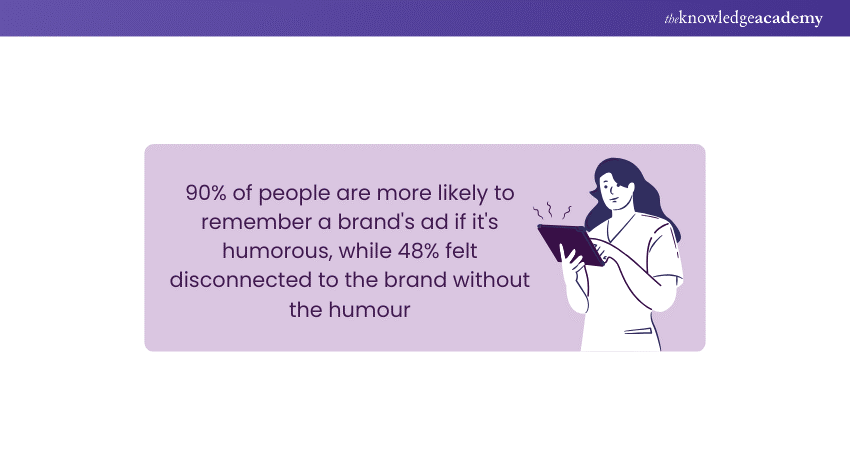
Using Second-person Language
The second-person language technique focuses on using "you" in the messaging. This engages the customers and keeps their attention, allowing them to consider themselves part of the narrative being created. It helps them visualise how the product or service could benefit their lives.
Celebrity Endorsements
Another potent tool for Persuasive Advertising is the use of influencers and celebrities to make a brand appeal more enticing to customers. It's natural for people to want to be like the people they admire, and when a celebrity testimonial or association can make your products appear more desirable.
The Carrot-and-Stick Approach
The carrot-and-stick approach is among the most popular Persuasive Advertising techniques. The carrot refers to the potential gains a customer will enjoy from using a product, and the stick refers to the potential loss a customer will incur if they don’t use the product.
An ad may highlight the benefits of using a product, such as better skin for a moisturising company, or point out the loss, like increased chances of robbery when a customer doesn’t buy a brand’s home security system. These sorts of persuasive strategies work because they target the most hardwired feelings.
Product Comparisons
This technique highlights the benefits of choosing your product over your competitors. An Advertisement using this technique includes two or more products and details of their specifications. The goal is to spotlight the positive characteristics of your product to encourage consumers to purchase it.
Hone your relationship-building skills in our detailed Building Business Relationships Course - Register now!
Six Examples of Persuasive Advertising
Now that you have a glimpse of the essential and proven Persuasive Advertising techniques, it’s time for some inspiration. These six brilliant innovative examples of Persuasive Advertising from renowned brands illustrate its effectiveness and will ignite your creativity as you gear up for your next marketing campaign
Burger King
Burger King appealed to the fans of the Netflix’s monster hit, Stranger Things, with the following piece of Persuasive Advertising. Burger King introduced an upside-down burger served in a theme box. This is an example of a brand tapping into a trending cultural phenomenon.
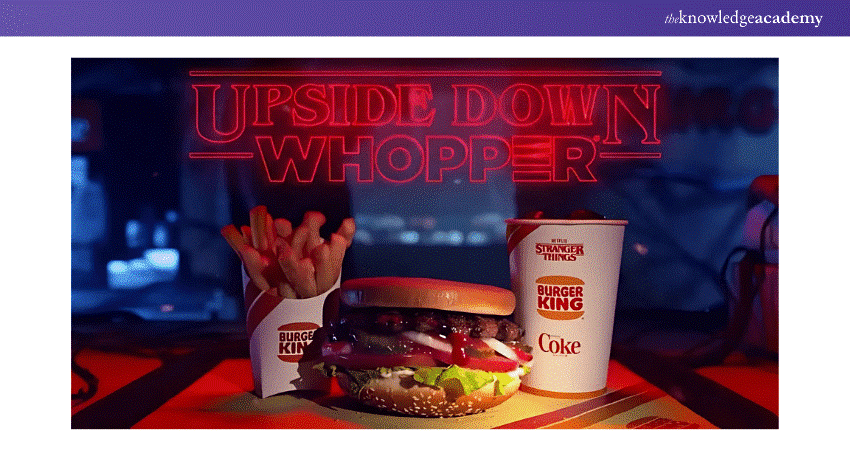
HP
HP, a global multinational device company, targeted a specific audience with its “Nobody’s Watching” campaign. This persuasive ad campaign centres around the users' ability to turn off the camera on their laptops, enabling them to do what they desire without worrying about being viewed by others.
By gearing the messaging to a specific audience’s concern about their product, HP was able to showcase why this is not an issue at all.
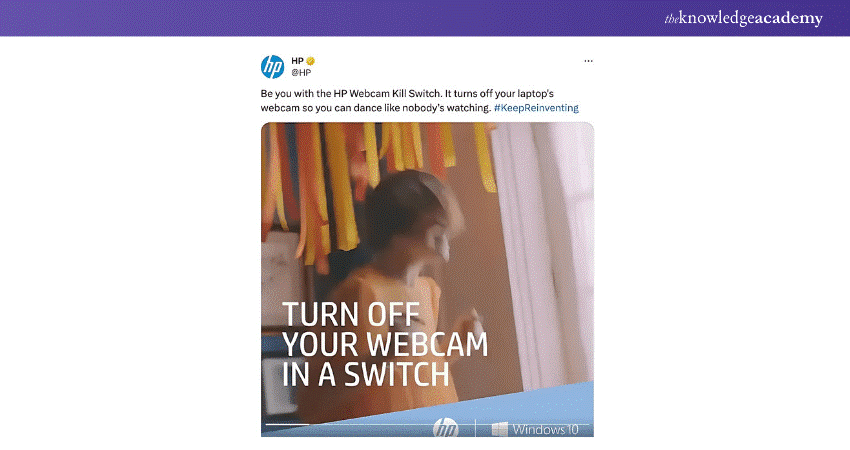
Lyft
Lyft’s Persuasive Advertising Campaign transforms the simple question, “Where are you going?" into a celebration of personal journeys, highlighting how every ride can be the pathway to meaningful experiences.
The name "Where Are You Going?" is inspired by the welcoming prompt that greets users of Lyft's mobile app. Through carefully crafted messaging and imagery, it likens reaching your destinations to reaching your full potential.
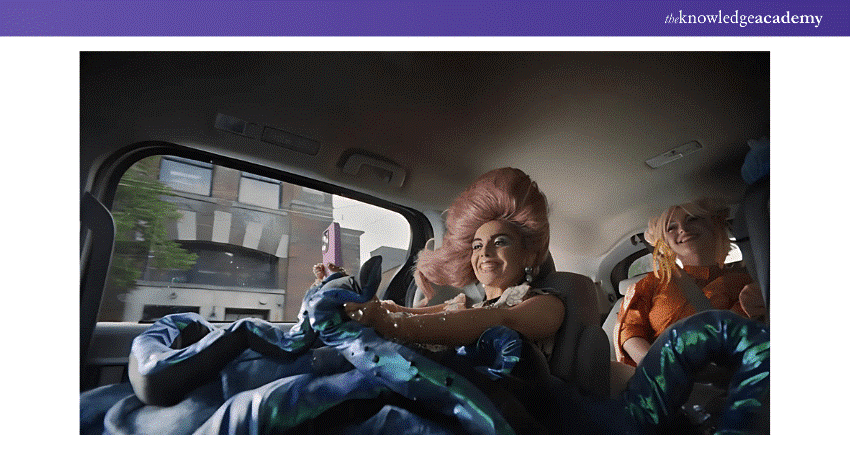
Apple
Apple, a global technological brand, appeals to reasonableness and logic to entice its audience to purchase its latest iPhone. Rather than comparing the smartphone to competitors, Apple focuses on what its product has to offer in the form of technological and physical advancements that its audience may find valuable.
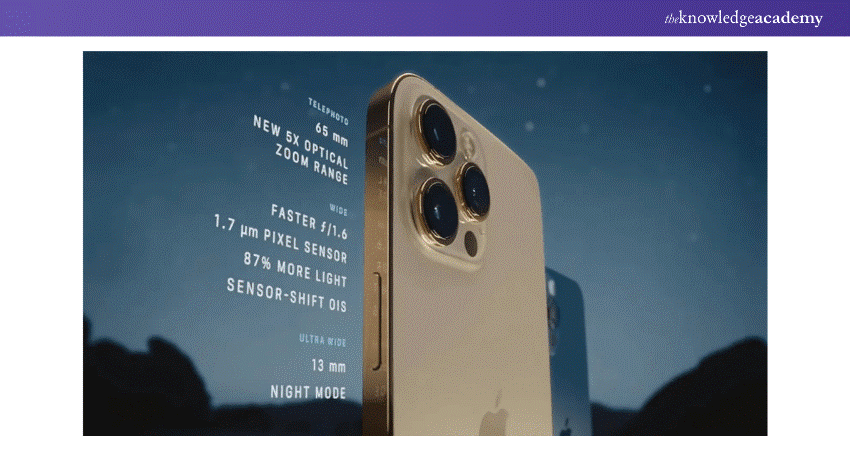
Pepsi
"More Than OK" is a persuasive ad campaign that pokes fun at how Pepsi usually takes a back seat to Coke. It featured a star-studded cast that includes Lil Jon, Steve Carell, and Cardi-B (who hilariously backs up Pepsi’s ‘OKness’). This campaign got a lot of laughs and persuaded a massive audience to reconsider their perception of the soft drink.
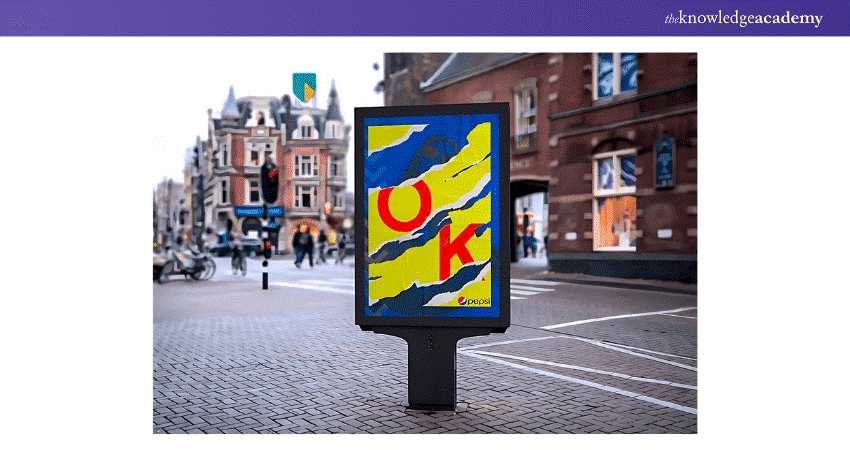
Mondo Pasta
With this use of guerrilla marketing, Mondo Pasta aligns their copy with the creative of a guy slurping the noodle who literally "can’t let go" because it's a rope tied to a dock. By designing such an engaging, funny, visual, and unexpected ad with a seemingly one-dimensional prop, the viewers can't let go of this ad either.
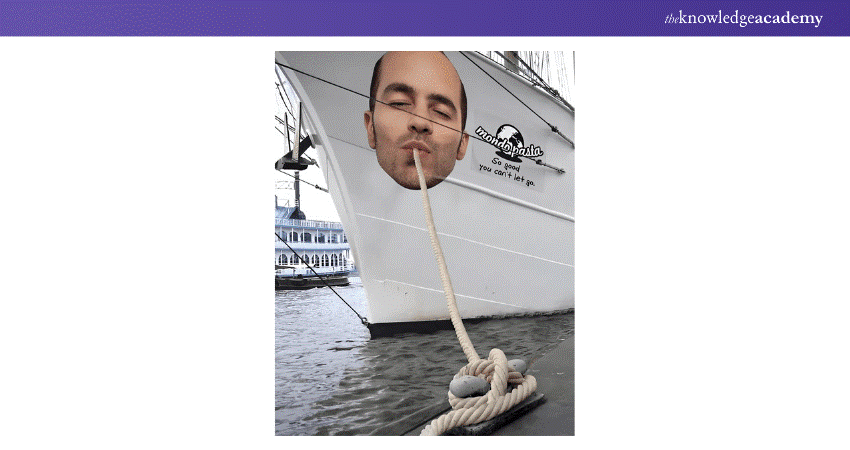
Heinz
Heinz uses the connotation of high temperature in relation to food to highlight the spiciness of their ketchup. This creative method of communicating the product's value helps them instantly attract people’s attention.
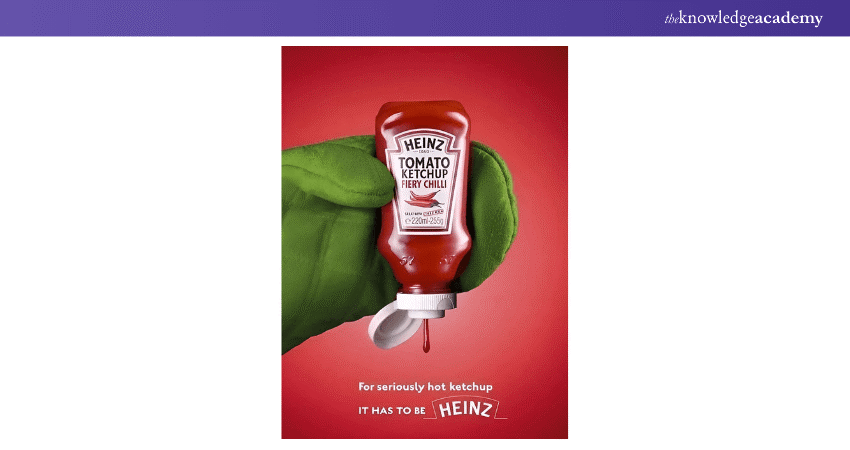
Nikol
Visually showcasing your product’s benefits in an exaggerated way is one of the best ways to capture attention and get an emotional response. This ad spotlights Nikol’s paper towels' absorbent powers in a brilliant over-the-top way by showing it turning grapes into raisins. With ads as creative as this, they can work without a single line of copy.
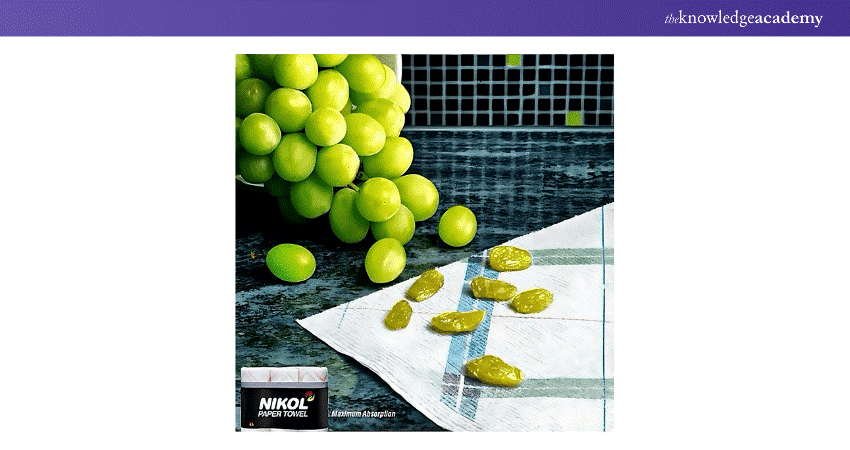
How to Make a Strategy for Persuasive Advertising?
Developing an Advertisement strategy with persuasive techniques requires an in-depth understanding of consumer psychology and the market. These steps will help you craft the ideal strategy for Advertising and persuasion:
1) Understand Your Audience: Knowing consumers' desires, needs, and pain points is essential. Psychographic and demographic analysis can reveal insights into what drives your target audience’s decisions and how they interact with similar products. Tailoring an approach based on these insights can significantly increase the relevance and impact of an ad campaign.
2) Define Clear Objectives: To drive your Advertising efforts, it's vital to have measurable, achievable, relevant, and time-bound (SMART) objectives. Whether the campaign goals are increasing sales, enhancing Brand Personality and awareness, or launching a new product, clarity in campaign goals is important for success.
3) Choose the Right Channels: Research where your target audience spends most of their time. Identifying the most effective platforms, be it social media, digital, print, or broadcast, ensures your messages reach your audience. Additionally, consider integrating these channels to create a seamless customer experience.
4) Craft Compelling Messages: Crafting messages that resonate intellectually and emotionally with your audience can transform passive viewers into loyal customers. This involves crafting not only the perfect message content but also its presentation and delivery.
5) Test and Refine: Finally, different approaches must be tested, and the strategy must be refined based on feedback and results. A/B testing various versions of the Advertisements can reveal what works best with the audience.
Conclusion
In conclusion, Persuasive Advertising streamlines a brand's success trajectory by tapping into consumers' emotions. This focus on emotions rather than facts is a big differentiator between this style of Advertisement and other forms. As detailed in this blog, you can craft powerful campaigns that resonate with your target audience through tactics like the scarcity principle, glittering generalities, celebrity endorsements, and many more.
Learn how to analyse consumer preferences and market trends in our Consumer Behaviour Course – Sign up now!
Frequently Asked Questions

Persuading in marketing involves focusing on influencing potential customers to take a desired action by tapping into their emotions.

The four factors of persuasive communication are:
a) Credibility
b) Common Ground
c) Evidence
d) Emotional Connection

The Knowledge Academy takes global learning to new heights, offering over 30,000 online courses across 490+ locations in 220 countries. This expansive reach ensures accessibility and convenience for learners worldwide.
Alongside our diverse Online Course Catalogue, encompassing 19 major categories, we go the extra mile by providing a plethora of free educational Online Resources like News updates, Blogs, videos, webinars, and interview questions. Tailoring learning experiences further, professionals can maximise value with customisable Course Bundles of TKA.

The Knowledge Academy’s Knowledge Pass, a prepaid voucher, adds another layer of flexibility, allowing course bookings over a 12-month period. Join us on a journey where education knows no bounds.

The Knowledge Academy offers various Personal Development Courses, including the Exceptional Customer Service Training and the Building Business Relationships Course. These courses cater to different skill levels, providing comprehensive insights into What is Customer Experience.
Our Business Skills Blogs cover a range of topics related to persuasion, offering valuable resources, best practices, and industry insights. Whether you are a beginner or looking to advance your persuasion skills, The Knowledge Academy's diverse courses and informative blogs have got you covered.
Upcoming Business Skills Resources Batches & Dates
Date
 Persuasion Training
Persuasion Training
Fri 3rd Jan 2025
Fri 7th Mar 2025
Fri 2nd May 2025
Fri 4th Jul 2025
Fri 5th Sep 2025
Fri 7th Nov 2025







 Top Rated Course
Top Rated Course



 If you wish to make any changes to your course, please
If you wish to make any changes to your course, please


